Pollen and the Pollination Process
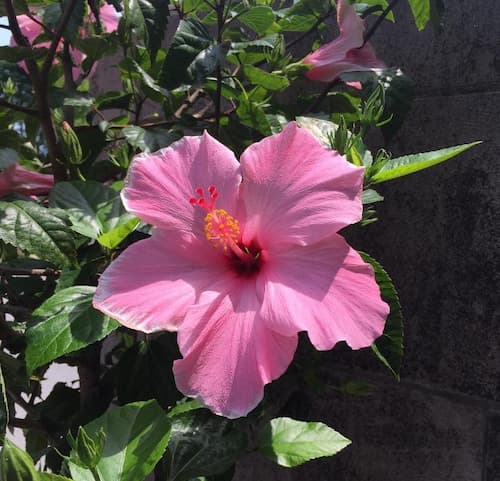
About Pollen and Pollination
Birds do it. Bees do it. And nowadays we do it– – pollinate our plants. In case you did not know, the nation’s Honeybees have been devastated by a major parasitic disease, along with the overuse of pesticides. Farmers always relied on Mother Nature and honeybee pollinators to do the pollination task. Now, humans often need to play a supporting role by practicing hand pollination techniques. Several companies are thriving in the business of bringing beehives into commercial farms and orchards, to perform the task of pollinating crops.
While honeybees have been the major pollinators, many insects act as pollinators. Some insects also perform the pollinating task in search of nectar, while others eat the pollen.
One of the most frequently asked questions on the topic of gardens is around pollination, in particular pollination problems.
Types of Pollinating Flowers
Some fruits and vegetables are self-pollinating. Self-pollinators have both male and female parts on the flower. Wind or insects spread the pollen easily, from within the flower. This makes the pollination task easy, and a good fruit set is more often assured. An example of this is tomatoes.
Other plants produce separate male and female flowers. This requires bridging a much larger distance to bring the male pollen to the stigma in the female flower for Successful pollination This is where the impact of a declining bee population has been most seriously felt.
Pollination - Identification of Male and Female Flowers
Assuming all has gone well, your plant will begin to form flowers. In most plants, the pollen-laden male flowers will come out first. (Doesn’t that sound familiar?). They will often proliferate a few days, to as much as two weeks, before the first female comes upon the scene. New growers worry that perhaps there is something wrong with the plant, as no females have appeared. This worry is heightened when talking with experienced growers, who invariably will be a week or so ahead of the novice grower and boasts of vegetables and fruit already growing on their plants. Never fear, your plant will develop female flowers, with tiny fruit attached behind them.
Male Flower Identification
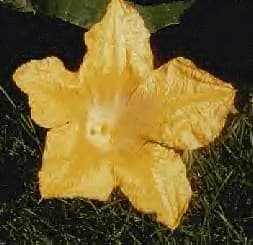
Male flowers are on a fairly thin stem, and usually extend up above, or out from, the branch or vine. The center stamen contains the pollen. The male flower opens up when the pollen is ripe. Pollen is mature if it readily comes off the stamen and onto your finger. It is fine, dust-like particles.
Female Flower Identification
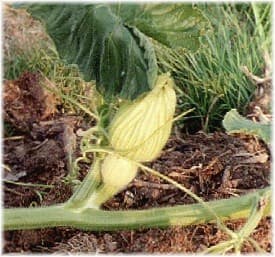
Female flowers are easily identified. A tiny baby fruit or vegetable is located between the stem and the flower. The baby fruit is more visible on larger fruits and vegetables, like cucumber, pumpkins, and watermelon. The female flower is on a short stem close to the vine. In the center is the “stigma”, which must receive the pollen for the fruit to develop. The picture to the left is of an immature female. To the right is a picture of a mature female with an open flower ready to accept pollen.
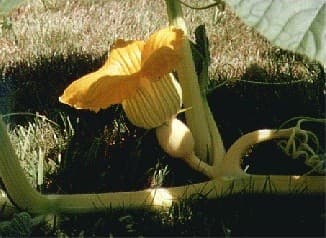
Is Plant Pollination Occuring?
The affirmative answer is apparent several days later, when the female flower has died and fallen off, and the tiny fruit beneath it begins to grow. The presence or absence of Honey Bees and other insects is a clue to whether pollination is occurring.
If pollination did not occur, the baby fruit or vegetable will shrivel and die.
Poor pollination can also occur. Pollination needs to be made to all segments of the female flower. If not, the fruit will not reach its maximum potential, and the number of seeds will be reduced.
Other factors affect good pollination, or “fruit set”. Among them are fertilizer imbalance, plant stress caused by too much or too little water, and excessive heat or cold.
Also see: Poor Plant Pollination – causes and cures
Nature's Way of Pollinating Flowers
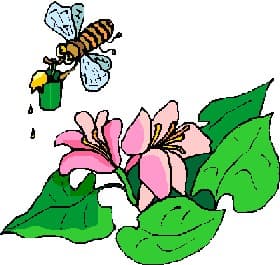
While the honey bee population is down, many other insects are pollinators. Any insect that is attracted to the flowers on your plants are potential pollinators. They only need to travel in the right sequence from the male flower to female flower…..the other way does not work.
Important: If pesticides are used, you are killing off the pollinators in your area. If you use them, stop a week or two before the flowers emerge. Do not resume spraying insecticides until the flowers are done blooming. Remember, pesticides will kill off the pollinators, including the Honey Bee.
Hand Pollination
Jokes about hand pollination abound, both on the internet, and in the field. Does anyone object to helping their plant to have sex? Okay, with that said, on to the learning…
By pollinating the flowers on your plants by hand, you assure several things. First, you use pollen from a male plant you select (versus Mother Nature- -random?). This eliminates cross and undesirable results in future crops from the resulting seed. Second, it assures pollination of the female flower, although nothing in nature is an ironclad guarantee. Third, it increases the likelihood of pollinating all segments of the female flower. Multi-segmented stigmas exist in the flowers of many plants. Proper pollination of all segments makes for bigger and better fruit, and seed development in vegetable crops.
Step by step:
Time pollination for the first day that a female flower opens its bud. You can usually tell the night before when it is ready to open.
Pollinate the plants in the early morning. The flowers will close in the afternoon, or towards evening.
Select a male flower. Pull off the petals to expose the Stamen, which contains the pollen.
Make sure the pollen is mature. Touch the stamen with your finger, to see if tiny specks of pollen come off on your hand.
Using the stamen itself (some growers opt to transfer it to a soft paintbrush), gently rub the pollen onto the inside stigma of the female flower. Make sure to come in contact with all segments of the stigma.
Hand pollination is now complete! Was it good for you? (Ooops. Sorry, I could not resist!).
Also see: Hand Pollination
Cross Pollination
Cross-Pollination from one plant of the same variety to another is good and healthy for a species. It is natures’ way of ensuring the survival of the species over time. Cross-pollination of one variety to another variety in the same family may be good, if you are experimenting with, or attempting to create new varieties or disease-resistant strains. But, it can be bad, if you are trying to grow a pumpkin and a cross with a Zucchini accidentally occurs.
More on: Cross-Pollination
Fruit Set
Fruit Set refers to the overall process of pollination and early growth of a fruit or vegetable. Proper fruit set has occurred after successful pollination. Other factors affect the proper setting of fruit. The emergence of male and female flowers is an important part of this process. Your fertilization program can impact this. Early in your plants’ life, an emphasis on placed upon Nitrogen to promote leaf, vine, and root growth. However, too much nitrogen for too long a period causes a delay in the flowering process. If this seems to be the case, first check with other growers in your area to see if their plants have begun to flower. Once you decide your flowers are late, stop putting any fertilizer with nitrogen on your plant for a week or two, and add more phosphorous.
A few other factors can affect fruit set. The most common is a mid-summer heatwave. High day and nighttime temperatures will cause plant stress. The tiny pollinated fruit may abort as a result. A heatwave can also deter bees from their job, making hand pollination more important. If your fruit is shriveling and dying and you are in the middle of a heatwave, don’t worry or panic. As soon as the weather cools you will see new females appear and successful pollination should occur.
While you can not completely cross out plant disease as a cause of poor fruit set, it is far less likely. If your plant is visibly healthy, is growing well, and you can find no evidence of disease, this is most likely not the cause of a poor fruit set. If you identify a disease problem, vigorously attack the problem. Once conquered, you should find successful pollination and growth even though it will be later in the season.
Related Articles
Poor Pollination – causes and cures
Please support our site. Shop for:
- rmmatthews100@hotmail.com
- 585-721-6528
- Rochester, NY
©1999-2024 GardenersNet.Com, All Rights Reserved

